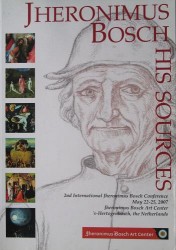
Caspers 2010
“A historical Reconstruction of The Pedlar by Jheronimus Bosch” (Charlotte Caspers) 2010
[in: Eric De Bruyn and Jos Koldeweij (eds.), Jheronimus Bosch. His Sources. 2nd International Jheronimus Bosch Conference May 22-25, 2007, ’s-Hertogenbosch, The Netherlands. Jheronimus Bosch Art Center, ‘s-Hertogenbosch, 2010, pp. 56-71]
The Jheronimus Bosch Art Center asked Caspers to paint a historical reconstruction of Bosch’s Rotterdam Pedlar. The main purpose was to inform the public of the Art Center about the build-up of a sixteenth-century painting and the materials used. In this contribution Caspers describes and evaluates the reconstruction process.
The restoration of the painting in 2001 and the dendrochronological analyses of this and several other Bosch paintings confirmed the hypothesis that The Pedlar was originally depicted on the outside of the wings of a triptych. Most fifteenth- and sixteenth-century Northern European panel paintings are painted on a chalk and glue ground. The Pedlar is characterized by a detailed underdrawing that could be studied by closely looking at the painting and by IR reflectograms. When the underdrawing and the paint surface are compared, there are some differences, for example the birds that are not painted in the background, or the changes in the dog and the size of the dagger. Most changes are of no importance to either iconography or composition. Similarity in composition and iconography between the Haywain and The Pedlar and especially similarities between the underdrawing of The Pedlar and the paint surface of the Haywain, suggest that The Pedlar was painted after the Haywain or that at least a common example was used.
The reconstruction resembles the original, in visual appearance, layer build-up and painting technique, but it is impossible to paint the same painting exactly again. The original painting has changed over time, the surface has a patina: craquelé, dirt, abrasion and discoloration. Though it is not an exact science, painting a historical reconstruction is a useful tool to study the technique used in a particular painting. Furthermore it also gives a realistic view of the painting practice to those not used to paint themselves. For the understanding of The Pedlar the reconstruction has been quite useful: Bosch worked quickly and skillfully sparing out shapes to be filled with different colours and a very limited and neat palette. On the one hand his technique follows the fifteenth-century tradition, in the materials used and the layer build-up, and on the other hand his technique is new in the limited amount of layers, its spontaneity and the use of a coloured ground. Studying other paintings ascribed to Bosch in the same way, will contribute to an insight in his development as a painter and might provide new material.
In this contribution there is no information that was not known before. In The Pedlar some of the differences between the underdrawing and the paint surface àre of importance to both iconography and composition: compare De Bruyn 2001a: 387 (note 1794)/389.
[explicit 12th October 2011]